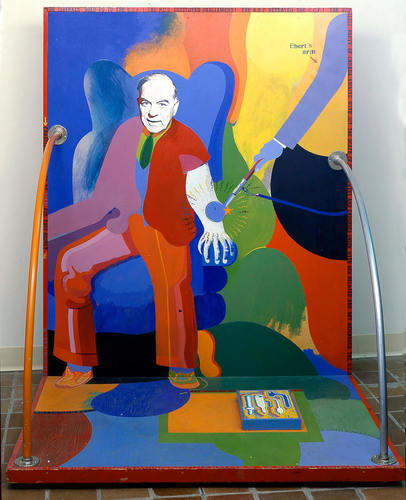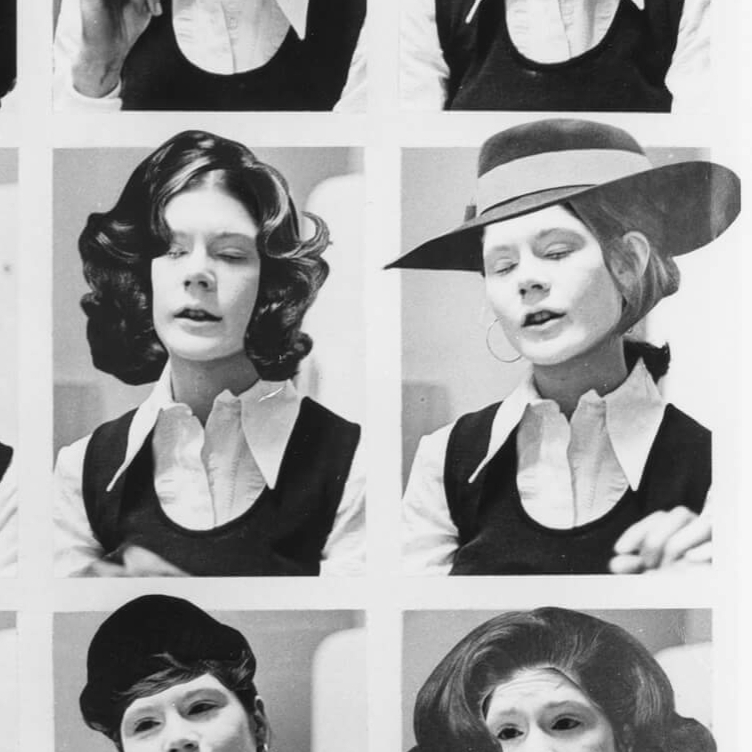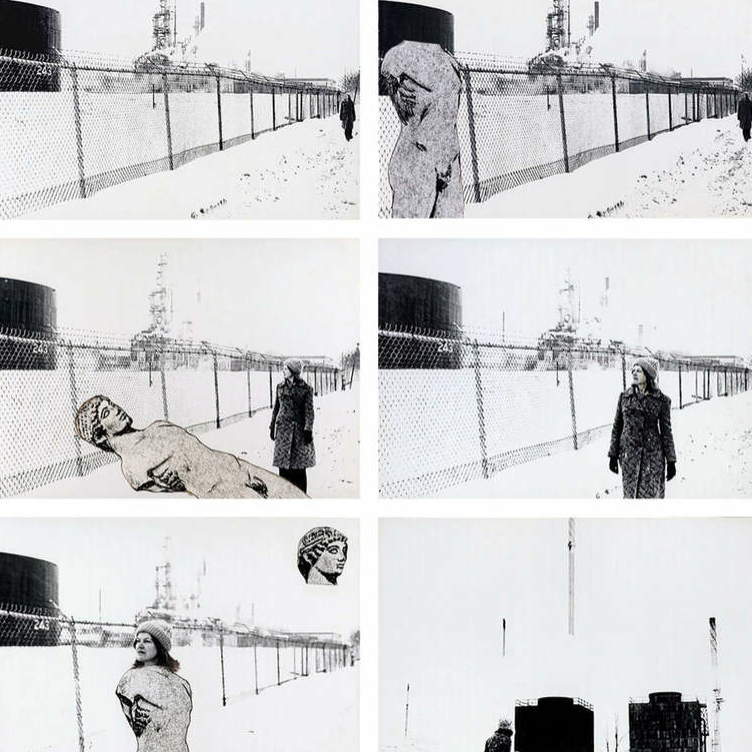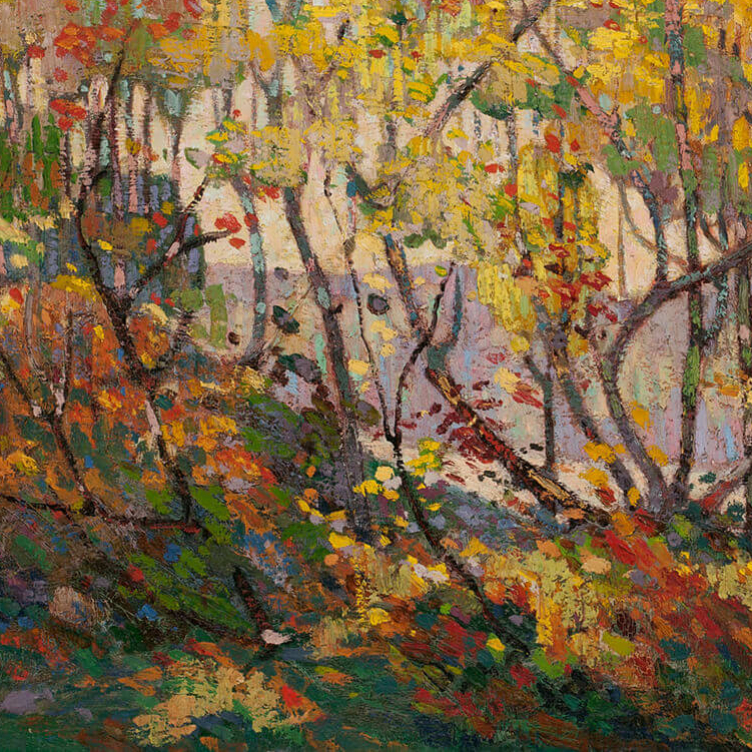London, Ontario, artist Greg Curnoe (1936–1992) began his career during a decade of change and turmoil in Canada and the world. The sexual revolution, the Vietnam War, the increasing American influence on life in Canada, and Canadian nationalism shaped his thinking and his work. Curnoe was well versed in debates about American imperialism and Canadian national identity, which were waged in the media and in books by George Woodcock, Mel Watkins, George Grant, and Léandre Bergeron. Like other artists such as Joyce Wieland (1930–1998) and John Boyle (b. 1941), Curnoe exhibited his passion for Canada in his paintings, in journal articles, and in letters to the editors of newspapers. He believed that Canadian identity resided in regional cultures across the country, rather than in a single, unified sense of identity.

Design for Curnoe’s centennial cake with text based on “Wild Thing” by The Troggs, c.1967
Pencil on paper, collection of Stephen Smart
His ambivalent Canadian nationalism is exemplified in his design for Canada’s centennial cake, which was served at the opening of 300 Years of Canadian Art at the National Gallery of Canada in Ottawa in 1967. Curnoe’s works often gave visual voice, usually with humour, to what was happening politically in Canada, whether in his portraits of political leaders or in works that posed ironic questions.
For a time, much of this cultural nationalism was directed against the United States. In other words, the reverse side of his Canadian patriotism was “anti-Americanism.” He admitted to being anti-American, but it is important to understand that he was not against individual Americans or aspects of American culture, such as artists, poets, jazz, or comic books. Indeed, it was Curnoe who commissioned an exhibition by American artist Bruce Nauman (b. 1941) at London’s 20/20 Gallery in 1970. Rather, he was concerned with the “cultural imperialism” that he observed with the appointment of Americans in Canadian universities and cultural institutions, and with the corporate takeovers that were happening in London and across the country.

Greg Curnoe, For Ben Bella, 1964
Oil on plywood construction, plastic, metal, and mixed media, 159.6 x 125.7 x 98.4 cm, Art Gallery of Alberta, Edmonton
Further, on his first trip to New York City in 1965, Curnoe had been shocked by the violent mugging of a friend. He subsequently re-evaluated his feelings about the United States. Curnoe refused to exhibit his work there and, true to his principles, later turned down a lucrative opportunity to design a cover for Time magazine. Tellingly, he also excluded a reference to the Time review of the National Gallery of Canada’s 1968 Heart of London exhibition in all of his files and bibliographic lists.

Greg Curnoe, 24 Hourly Notes, December 14–15, 1966
Stamp pad ink and acrylic on galvanized iron, 24 panels, each 25.4 x 25.4 cm, Art Gallery of Ontario, Toronto
Curnoe’s patriotism overlaid with anti-Americanism led to controversy and censorship. The 1968 removal of his mural from the Montreal International Airport in Dorval, Quebec, because of anti-American statements is still one of the best-known examples of censorship in Canadian art history. Several months later, three panels of 24 Hourly Notes, December 14–15, 1966, were removed from an exhibition in Edinburgh because of “indecent” words. When the same work was exhibited at the National Gallery of Canada in Ottawa in 1970, a member of Parliament asked the prime minister, Pierre Elliott Trudeau, to have it removed. The work remained on exhibition. Both these issues resulted in significant national media coverage, including defensive responses from Curnoe.

Greg Curnoe, Tecumseh/Apollinaire, November 4, 1980
Watercolour and pencil on paper, 23 x 18 cm, private collection
Toward the end of his career, Curnoe began to realize the ultimate irony of the cultural imperialism of his own British ancestors. He had probably become more aware of Indigenous history in Canada from his friend and mentor Selwyn Dewdney (1909–1979), an expert in Indigenous pictographs. While Curnoe made earlier references in his work to Métis leader Louis Riel and the Shawnee hero Tecumseh, who lost his life close to London in 1813 at the Battle of the Thames, it was not until he began researching the pre-colonial history of his property at 38 Weston Street in London that a new understanding of Canadian identity began to emerge. As literary and cultural critic Frank Davey noted, “[Curnoe] felt strongly that as a white individual he had benefitted directly from the injustices First Nations people had suffered and that a major part of that benefit was hidden in the Canadian ‘forgetting’ of thousands of years of First Nations social development and inhabiting of the land.”
This Essay is excerpted from Greg Curnoe: Life & Work by Judith Rodger.
 Karen Tam’s Autumn Tigers
Bridging Past and Present: Invisible Made Visible
By Imogene L. Lim, PhD
Karen Tam’s Autumn Tigers
Bridging Past and Present: Invisible Made Visible
By Imogene L. Lim, PhD
 The Frontier Portraits of C.D. Hoy
A Chinese Canadian Photographer’s Tribute to His Community
By Faith Moosang
The Frontier Portraits of C.D. Hoy
A Chinese Canadian Photographer’s Tribute to His Community
By Faith Moosang
 Interrogating Identity
Suzy Lake explores the role of photography in shaping how we understand and see ourselves
By Erin Silver
Interrogating Identity
Suzy Lake explores the role of photography in shaping how we understand and see ourselves
By Erin Silver
 An Emboldened Artist
How Oviloo Tunnillie achieved rare international acclaim as an Inuit female sculptor
By Darlene Coward Wight
An Emboldened Artist
How Oviloo Tunnillie achieved rare international acclaim as an Inuit female sculptor
By Darlene Coward Wight
 Painting the Cultural Mosaic
William Kurelek traversed the country in a quest to capture its diverse inhabitants
By Andrew Kear
Painting the Cultural Mosaic
William Kurelek traversed the country in a quest to capture its diverse inhabitants
By Andrew Kear
 Domestic Discontent
Mary Pratt’s poetic scenes of home life are praised for their political edge
By Ray Cronin
Domestic Discontent
Mary Pratt’s poetic scenes of home life are praised for their political edge
By Ray Cronin
 A New Vision of the North
Annie Pootoogook’s art offers unprecedented insights into the contemporary Arctic
By Nancy G. Campbell
A New Vision of the North
Annie Pootoogook’s art offers unprecedented insights into the contemporary Arctic
By Nancy G. Campbell
 Meetings of Minds
Sorel Etrog found new ideas in collaborative work
By Alma Mikulinsky
Meetings of Minds
Sorel Etrog found new ideas in collaborative work
By Alma Mikulinsky
 Introducing Miss Chief
An excerpt from the ACI’s book “Revision and Resistance”
By Shirley Madill
Introducing Miss Chief
An excerpt from the ACI’s book “Revision and Resistance”
By Shirley Madill
 A Practice of Recovery
An excerpt from the ACI’s book “Revision and Resistance”
By Sasha Suda
A Practice of Recovery
An excerpt from the ACI’s book “Revision and Resistance”
By Sasha Suda
 Decolonizing History Painting
An excerpt from the ACI’s book “Revision and Resistance”
By Ruth B. Phillips and Mark Salber Phillips
Decolonizing History Painting
An excerpt from the ACI’s book “Revision and Resistance”
By Ruth B. Phillips and Mark Salber Phillips
 A Vision for the Future
An excerpt from the ACI’s book “Revision and Resistance”
By Nick Estes
A Vision for the Future
An excerpt from the ACI’s book “Revision and Resistance”
By Nick Estes
 Inside Kent Monkman’s Studio
An excerpt from the ACI’s book “Revision and Resistance”
By Jami C. Powell
Inside Kent Monkman’s Studio
An excerpt from the ACI’s book “Revision and Resistance”
By Jami C. Powell
 The Rule of Chance
Jean Paul Riopelle’s break with Automatism
By François-Marc Gagnon
The Rule of Chance
Jean Paul Riopelle’s break with Automatism
By François-Marc Gagnon
 From Taos to New York
Agnes Martin and the currents of American Art
By Christopher Régimbal
From Taos to New York
Agnes Martin and the currents of American Art
By Christopher Régimbal
 An Artist Blooms
Mary Hiester Reid’s floral aesthetics
By Andrea Terry
An Artist Blooms
Mary Hiester Reid’s floral aesthetics
By Andrea Terry
 Walking, Stacking, Dancing
Françoise Sullivan’s conceptual 1970s
By Annie Gérin
Walking, Stacking, Dancing
Françoise Sullivan’s conceptual 1970s
By Annie Gérin
 The Extraordinary North
Tom Thomson’s diary of landscape
By David P. Silcox
The Extraordinary North
Tom Thomson’s diary of landscape
By David P. Silcox
 A Champion of Abstraction
Jock Macdonald sought a new expression in art
By Joyce Zemans
A Champion of Abstraction
Jock Macdonald sought a new expression in art
By Joyce Zemans
 Defiant Spirit
Quebecois artist Ozias Leduc drew on Europe but created a Canadian ideal
By Laurier Lacroix
Defiant Spirit
Quebecois artist Ozias Leduc drew on Europe but created a Canadian ideal
By Laurier Lacroix